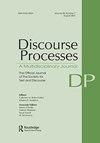当有多个备选方案可用时,预测推断的表示
IF 2.1
2区 心理学
Q2 PSYCHOLOGY, EDUCATIONAL
引用次数: 0
摘要
摘要最近的研究表明,当一种情况可能导致多种相互排斥的后果时,人们会在记忆中自动产生多种预测推断。已经提出了几种理论机制来解释预测推断的产生。一种假设是,推理是最低限度编码的,仅由与推理相关的一组语义特征表示,或由涵盖两种推理结果的更一般的概念表示。第二个假设是,推断的激活被延迟,因为它最初很弱,需要时间来构建。在三个旨在检验这两个假设的实验中,参与者阅读了支持互斥结果的叙事段落。使用单词命名任务在工作记忆中没有检测到预测推断,即使是在较长的延迟下,但使用短期矛盾范式检测到了预测推断,因此可以作为话语表征的一部分。组合结果表明,预测推断是最低限度地编码的,而不是它们的激活被延迟。本文章由计算机程序翻译,如有差异,请以英文原文为准。
Representation of predictive inferences when multiple alternatives are available
ABSTRACT When a situation could lead to multiple mutually exclusive consequences, recent research shows that people automatically generate multiple predictive inferences in memory. Several theoretical mechanisms have been proposed to account for the generation of predictive inferences. One hypothesis is that inferences are minimally encoded, represented only by a set of semantic features related to the inferences or by a more general concept that covers the consequences of both inferences. A second hypothesis is that activation of the inferences is delayed because it is initially weak and requires time to build. In three experiments designed to examine these two hypotheses, participants read narrative passages that supported mutually exclusive consequences. Predictive inferences were not detected in working memory using a word-naming task, even at longer delays, but were detected using a short-term contradiction paradigm and, therefore, available as part of the discourse representation. The combined results indicate that predictive inferences are minimally encoded rather than their activation being delayed.
求助全文
通过发布文献求助,成功后即可免费获取论文全文。
去求助
来源期刊

Discourse Processes
Multiple-
CiteScore
4.30
自引率
4.50%
发文量
27
期刊介绍:
Discourse Processes is a multidisciplinary journal providing a forum for cross-fertilization of ideas from diverse disciplines sharing a common interest in discourse--prose comprehension and recall, dialogue analysis, text grammar construction, computer simulation of natural language, cross-cultural comparisons of communicative competence, or related topics. The problems posed by multisentence contexts and the methods required to investigate them, although not always unique to discourse, are sufficiently distinct so as to require an organized mode of scientific interaction made possible through the journal.
 求助内容:
求助内容: 应助结果提醒方式:
应助结果提醒方式:


